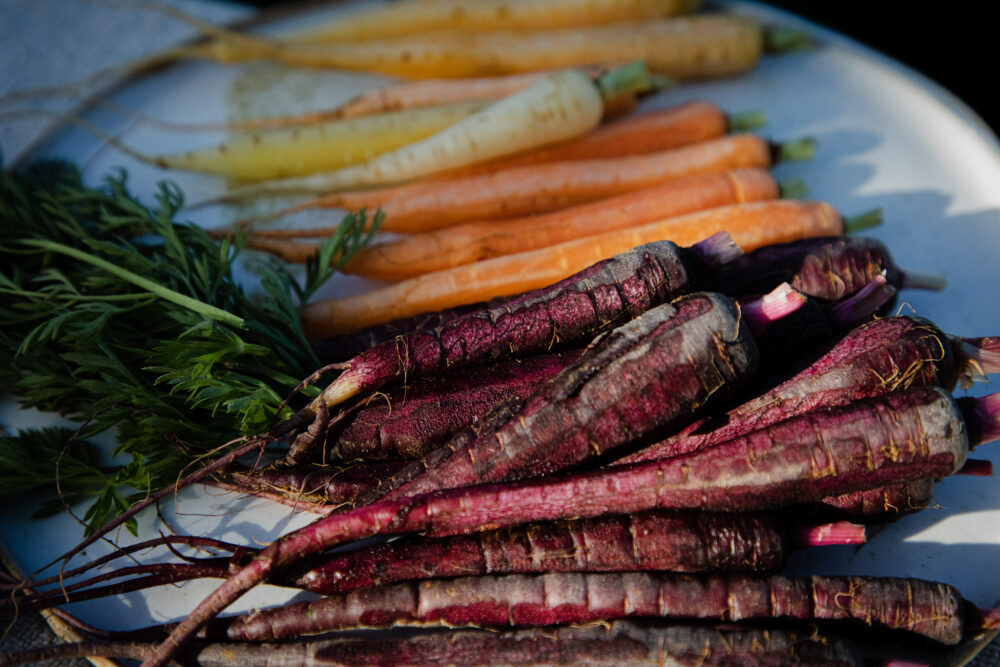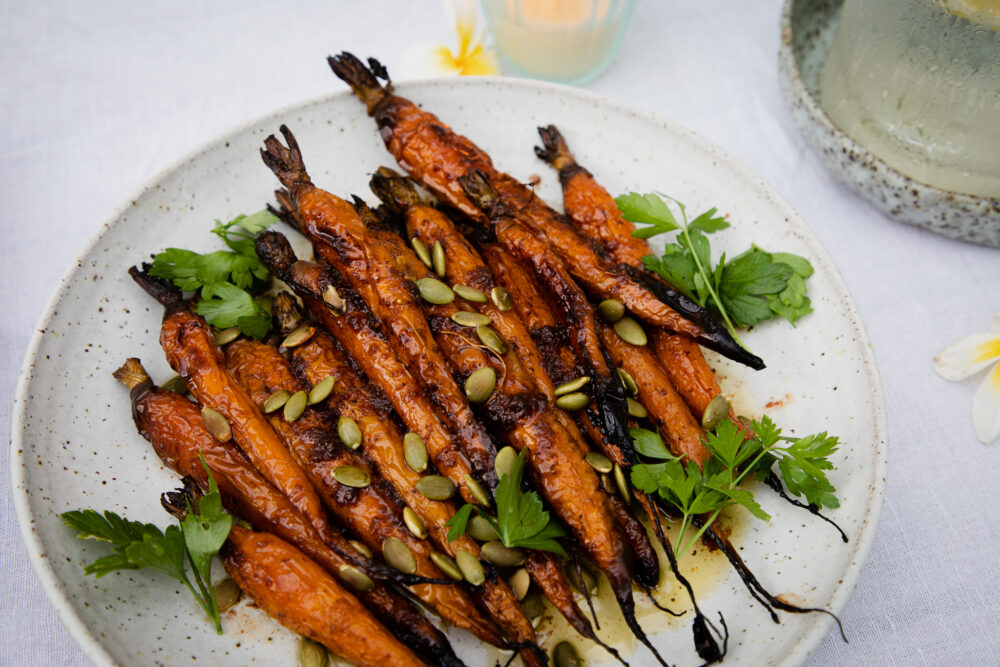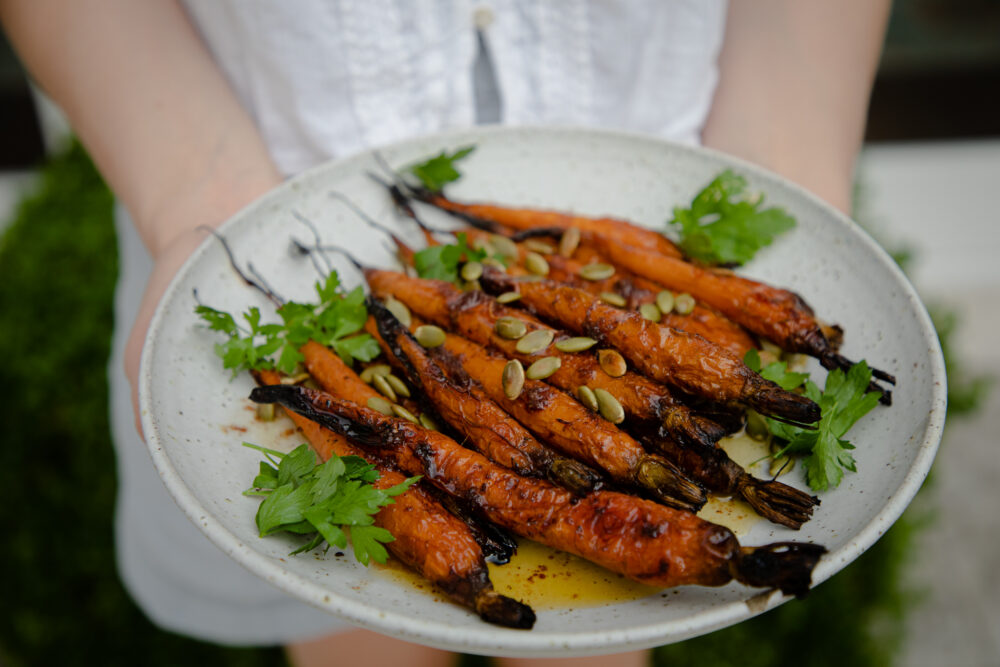Brown butter honey roasted carrots
I think these brown butter honey roasted carrots are a beautiful dish to serve for a special meal.
There’s something rather elegant about these small carrots, drizzled with a delicious golden sauce, flavoured with freshly grated nutmeg.
Brown butter, or beurre noisette, as it’s known in French, is one of my favourite flavours. Use the best quality unsalted butter you can.
I love watching the butter foam in the pan as it melts.
As the water evaporates from the butter, the milk solids turn brown and sink to the bottom of the pan, leaving a gorgeous golden liquid.
Add a little freshly grated nutmeg, salt, honey and apple cider vinegar, and you have a beautiful sauce to toss into Dutch carrots before roasting.
Dutch carrots
Originally purple, black or red, the orange carrot most commonly eaten today was developed by the Dutch in the 17th century.

The origins of the carrot
The carrot (Daucus carota) is a descendant of a a wild ancestor, which may not bear much resemblance to today’s version.
Carrots are classed as root vegetables, and indeed wild carrots do resemble long, twisted, spindly roots. While edible when very young, they quickly became too woody to eat.
Nonetheless, wild carrot seeds have been found in archaeological sites dating back over 5,000 years and spread across wide temperate zone areas, so they were clearly a popular forage food.
Early cultivation
The first possible mentions of deliberately cultivated carrots are found in texts from ancient Greece and Rome.
Traditionally, the wild carrot was utilized by the ancient Greeks and Romans for various medicinal purposes.
However, there is firm evidence from the 10th century that true carrots were both grown and stored in the area that is now Iran and Afghanistan.
These early carrots were white or purple, and still offered fairly thin nourishment compared to modern roots.
Development of the modern carrot
Over the years, selective breeding and better growing expertise gradually led to fatter roots more closely resembling today’s examples.
Along the way, a random genetic mutation also led to the appearance of a new yellow variety, which quickly became popular because of its sweeter flavour.
Selective breeding once again played a part in strengthening this sweetness, and a side-effect was a deepening of the colour into the familiar orange, as the levels of beta carotene were increased.
By the 16th century, examples of familiar orange carrots began to appear in contemporary paintings of market scenes in the Netherlands and Spain.
Orange carrots were larger, sweeter, more densely packed with nutrients, and also kept better in storage. All this led them to becoming the dominant type, providing more nutrition and taste per plant.
Cooking Dutch Carrots
Dutch carrots can be eaten raw or steamed, roasted, baked and even juiced.
They are small and tender enough to be roasted or boiled whole quite quickly as they don’t have the dense heart of larger carrots. For this dish, they’re cooked for a while so as to achieve that lovely, caramelised flavour.

More carrot recipes
If you’re a fan of roasted carrots, you might like to try these roasted carrots with walnuts and hummus.
Best wishes,
Amanda
PS: If you’ve tried these brown butter honey roasted carrots or any other recipe from At Amanda’s Table, please let me know how it turned out in the comments below.
And, if you’d like to read more, please subscribe to my newsletter for stories, recipes and tips for simple, nutritious meals.
Brown Butter Honey Roasted Carrots
Ingredients
- 2 bunches Dutch carrots
- 80 g unsalted butter
- 1 tbsp honey
- 1/2 nutmeg, grated
- 1/2 tsp sea salt
- 1 tbsp apple cider vinegar
- 1/4 cup pumpkin seeds
- handful Italian parsley leaves, to garnish
Instructions
- Preheat the oven to 200℃ and line a baking tray with paper.
- Trim the leafy tops off the carrots. Wash them and then place in the baking dish.
- In a small saucepan, heat the butter gently over a medium heat until it turns brown and starts to bubble.
- When the butter turns clear, add the salt, pepper, grated nutmeg, honey and vinegar. Stir until the honey has melted. Remove from heat.
- Toss the carrots in half of the butter honey mixture. Line the carrots up in a single layer and roast for 30 - 45 minutes (depending on their size) until the carrots are soft when pierced with a knife.
- Reheat the remaining butter honey mixture until it's runny (it will cool and harden if left for a while).
- Arrange the carrots on a platter, pour over the the remaining mixture, then sprinkle with toasted pumpkin seeds and parsley leaves before serving. Carrots can be served hot or room temperature.

Leave a Reply